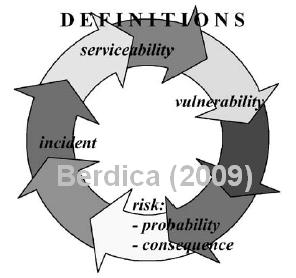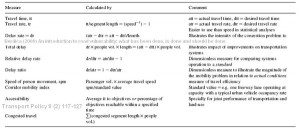 Today we are going back in time, to one of the seminal articles in road vulnerability. Katja Berdica‘s 2002 article, An introduction to road vulnerability: what has been done, is done and should be done has laid the groundwork for many researchers, and has cited by not few authors since it was first published. It is a conceptual paper that provides the basis for why road vulnerability needs to be a more important issue than it usually is considered as. It is also the first paper to develop a framework for measuring road vulnerability.
Today we are going back in time, to one of the seminal articles in road vulnerability. Katja Berdica‘s 2002 article, An introduction to road vulnerability: what has been done, is done and should be done has laid the groundwork for many researchers, and has cited by not few authors since it was first published. It is a conceptual paper that provides the basis for why road vulnerability needs to be a more important issue than it usually is considered as. It is also the first paper to develop a framework for measuring road vulnerability.
A career-shaping discovery
Berdica’s article is based on her PhD thesis on the same topic, and I learned about her PhD in 2002, when Harvey Miller, one of my professors from the University of Utah, came back from Sweden, where he had attended her defense. At that time where I was working on a PhD in Geography on hazards to transportation lifelines; eventually I discontinued and went back to Norway, but that’s another story. In any case, Berdica’s PhD, and the references I found in there, (e.g. Dalziell, E., & Nicholson, A. J. (2001). Risk and impact of natural hazards on a road network) is what really got me started in my research interest in transport network vulnerability.
What is road vulnerability?
Although it may be convenient to define vulnerability as a problem of reduced accessibility, the theory pertaining to accessibility approaches the issue of vulnerability form the demand side. In reality, for analyzing vulnerability, the issue at hand is the supply side, meaning the actual existence of a functioning route from one location to the other. With this in mind, Berdica sets out the following definitions:
The serviceability of a link/route/road/network describes the possibility to use that link/route/road/network at a given time.
An incident is an event, which directly or indirectly may result in considerable reduction or interruption in the serviceability of a given link/route/road/network.
Risk is a composite of the probability of an incident to occur and the resulting consequences, should the incident occur.

Vulnerability of a road transportation system is the susceptibility to incidents that can result in a considerable reduction in road network serviceability.
Reliability is the complement to vulnerability and describes adequate serviceability under the operating conditions encountered at a given time.
With reliability as a complement to vulnerability, the issue of vulnerability can now be described in the well-established terms of reliability theory, (i.e. the probability of functioning or non-functioning) where vulnerability in essence means non-reliability.
What is road reliability?
Following the above definition, where vulnerability leans on reliability, Berdica then gives a brief description over some of the work related to transportation reliability:
- reliability of connectivity
- reliability of travel time
- reliability of capacity
Reliability of connectivity is the probability of reaching the chosen destination at all. Reliability of travel time is the probability of reaching the chosen destination within a given time frame. Reliability of capacity is the probability of the network being able to accomodate a certain amount of traffic. However, different from the traditional system functioning and non-functioning perspective, Berdica adds the notion of serviceability acceptable or non-acceptable. This means that reliability, and in particular vulnerability, pertains not to an on-off measure, but to a degree measure, a degree measure that is related to performance.
How to measure road vulnerability?
Berdica defines a set of performance measures for transportation systems:
 Click image for larger version
Click image for larger version
While these do not relate directly to vulnerability, the degre of change in these measures following an incident can be seen as a meassure of the transportation system’s vulnerability to the given incident.
How to study road vulnerability?
Berdica says the road vulnerability analysis regards the road network as a whole and involves identifying a spectrum of incidents, collecting data on probabilities and consequences in order to estimate risk, preforming various studies to set values for desirable or acceptable serviceability (performance), as well as investigating the effects of possible mitigation and improvement strategies. Vulnerability analysis of road networks is suggested as an all-embracing framework that ought to be integrated into all the different stages of infrastructure development: optimizing investment planning, optimizing road maintenance, and daily operations management.
Conclusion
Over the years I have become very fond of Berdica’s article, because it has provided me with the bedrock for my own research, since it provides numerous and practically never-ending research opportunities, as Berdica states herself:
Road vulnerability analysis could thereby be regarded as a hub for the whole battery of transport studies needed to gain the insights necessary to describe how well our transport systems work in different respects, what steps to take and what policies to implement in order to reach desired goals […] vulnerability in the road transportation system should be brought out and recognized as a crucial part in the infrastructure, and […] be the meeting point for all the different strands of transport reliability research and other issues.
For more on my own research approach the interested reader is referred to my philosophical essay on Transportation reliability and vulnerability – a question of cost and benefit?
Reference
Berdica, K. (2002). An introduction to road vulnerability: what has been done, is done and should be done Transport Policy, 9 (2), 117-127 DOI: 10.1016/S0967-070X(02)00011-2
Author link
- linkedin.com: Katja Berdica












